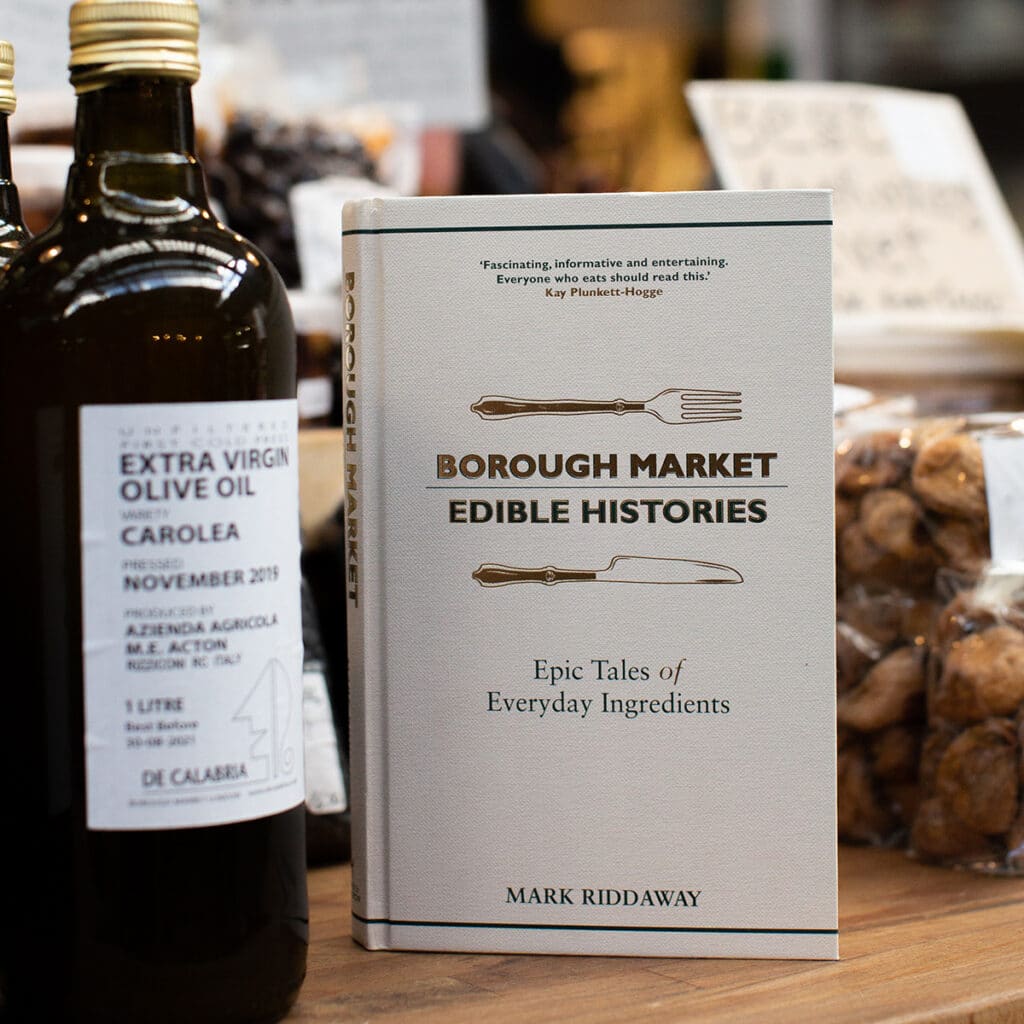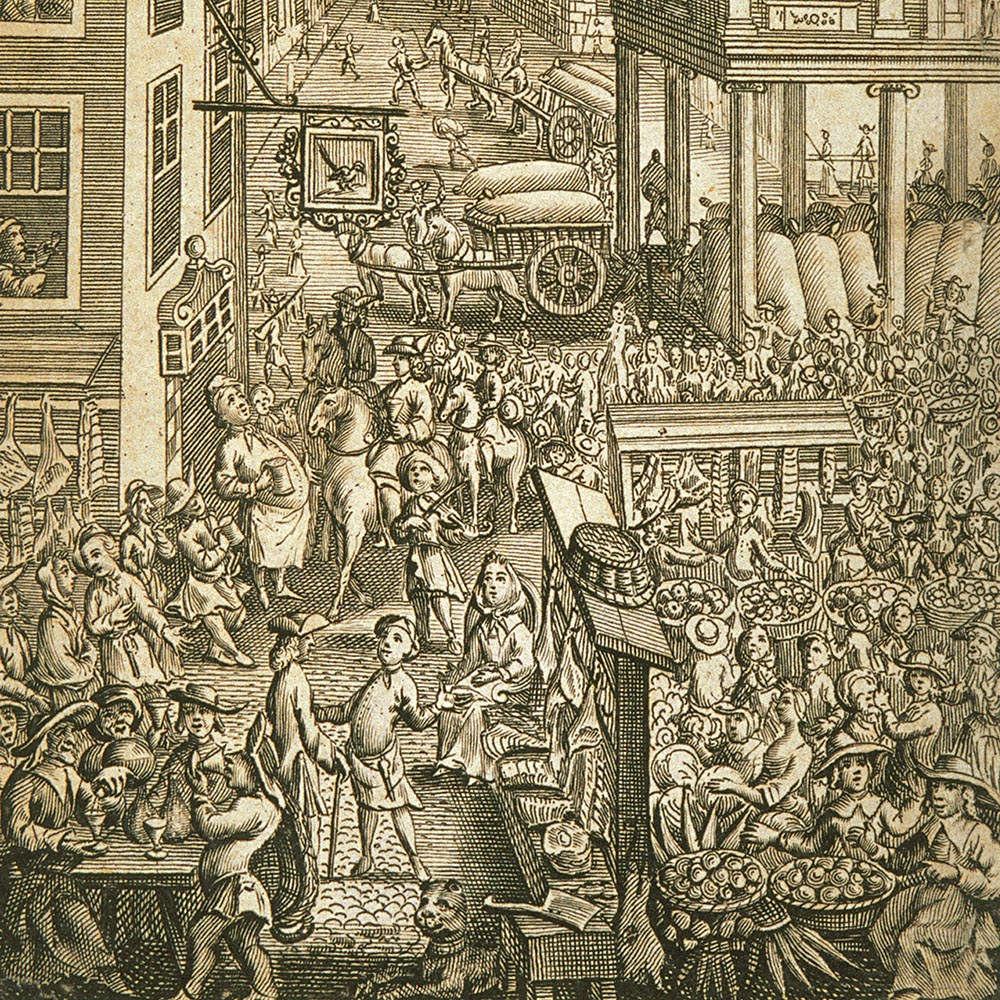Edible Histories: the tomato
In an extract from his Fortnum & Mason Food & Drink Awards shortlisted book, Borough Market: Edible Histories, Mark Riddaway explores why the British spent hundreds of years ignoring the tomato


“AN ENGLISH DICTIONARY PUBLISHED IN 1677 DESCRIBED THE TOMATO AS ‘A SPANISH ROOT OF A COLOUR NEAR VIOLET’”
In his book Borough Market: Edible Histories, Mark Riddaway tells the epic tales of some of the everyday ingredients found on Borough Market’s stalls. This extract from the chapter on the tomato offers a taste of the surprising stories found within.
Much of what we know about the tomato’s early cultivation in Europe after it was brought across the Atlantic from its Mexican homeland can be found in the writings of the continent’s burgeoning community of herbalists, and their responses to this oddest of fruits were almost uniformly wary.
The earliest substantial reference to the tomato’s presence in Europe was penned by the Italian herbalist Pietro Andrea Mattioli in his Discorsi (1544). Mattioli suggested that this exotic new fruit, which he deemed it unnecessary to name, was a new species of aubergine – itself a fairly recent arrival, having migrated from Asia following the Arab invasions of Spain and Sicily. He wrote: “Another species has been brought to Italy in our time, flattened like the ‘mele rose’ [a variety of apple] and segmented, green at first and when ripe of a golden colour.” It was “eaten in the same manner” as the aubergine: fried in oil and seasoned with salt and pepper.
Ten years later, in a revision to his book, Mattioli alighted upon a name: ‘pomo d’oro’, meaning ‘golden apple’, later established in Italian as ‘pomodoro’. That same year, 1554, the Flemish physician Rembert Dodoens published both a woodcut picture of a tomato and a stark warning to anyone thinking that Mattioli’s fried, seasoned tomato slices sounded nice: “This is a strange plant and not found in this country except in the gardens of some herbalists, where it is sown … the complexion, nature and working of this plant is not yet known, but by that I can gather of the taste, it should be cold of nature, especially in the leaves, somewhat like unto the mandrake, and therefore also it is dangerous to be used.”
According to the enduring Galenic theory of ‘humours’ – a classical philosophy named after Galen, a 2nd century Greco-Roman physician – all plants offered a blend of four inherent ‘qualities’: hot, cold, moist and dry. Eating them could be either beneficial or dangerous, depending upon the current state of your body’s four humours (blood, yellow bile, black bile and phlegm), an imbalance of which would lead inevitably to illness. Tomatoes were deemed to be moist and extremely cold – according to Gerard, “perhaps in the highest degree of coldness” – which could be highly problematic. The consumption of a cold, moist food would, it was believed, be likely to result in a dangerous excess of phlegm, particularly in cold, damp countries like this one, where people were considered naturally phlegmatic and hot-bloodedness was rare.
As a result, most writers deemed the tomato to be corruptive. In England, a book from 1600 warned that “the fruit being eaten provoketh loathing and vomiting”, a result more commonly associated today with the late-night doner kebab. The Venetian botanist Pietro Antonio Michiel insisted that a tomato’s smell alone could cause eye diseases and headaches, while the physician Giovanni Domenico Sala, writing in 1628, called them “strange and horrible things” that only “a few unwise people” were willing to eat.

Humours aside, this reticence is easy to understand. Tomatoes were both foreign – although contemporary writers were highly confused as to their origins: Peru? India? Spain? – and odd. They didn’t look or taste like anything a European had seen before, and they probably didn’t taste anything like as good as they do now, after centuries of selective breeding. Their association with the aubergine didn’t help – known as the ‘mala insana’ (‘mad apple’), the aubergine was, wrote Michiel, “harmful to the head”, so being categorised alongside it was far from a compliment. Plus, the leaves and stems have an unusually strong smell and are indeed mildly toxic. Applied externally, the juice of the tomato was thought to be effective for the treatment of scabies or burns, but when it came to using the fruit for food, the consensus was solid: steer clear.
Largely because it was known in some places as the love apple (‘pomme d’amour’ in French), it is often stated that the tomato was considered an aphrodisiac – and some herbals of the time do allude to this reputation – but there is little evidence of this having had any practical consequences (indeed, ‘cold’ foods were considered passion killers, not a source of ardour). No one was eating tomatoes in the hope of a night of passion. In fact, people weren’t even eating them in the hope of a nice salad. Across most of Europe, the tomato grew widely in botanical gardens, but rarely found its way into the kitchen.
Italy and Spain, though, were different – southern Italy, in particular, where people were traditionally less averse to the consumption of vegetables than, for example, the meat-obsessed English, who considered plants the lowest form of sustenance. The influence of Spain, which ruled the kingdoms of Naples, Sicily and Sardinia for a large part of the early modern period, was also marked, making the region fertile ground – in every sense – for the Spanish conquistadores’ New World discoveries. By the end of the 17th century, Antonio Latini, chef to a noble household in Naples, was happily using tomatoes in the palace kitchen without any concern for the resulting levels of phlegm production. Latini’s book, Lo Scalco alla Moderna, published in the 1690s, included a sauce of tomato, chilli, thyme, salt, oil and vinegar, a dish of sautéed aubergine, onion, squash and tomato, and ‘cassuola di pomadoro’, in which roasted tomatoes were added to a stew of pigeon, veal, chicken necks, herbs, eggs and lemon juice. Oh, and for real savoury depth, some testicles. Two of Latini’s recipes referred to the tomato as being of the ‘Spanish style’ – an indication that the use of this fruit still felt a little foreign, even in its new heartland.
It was in the works of another Neapolitan chef, writing around a century later, that southern Italian cuisine could be seen to be truly taking the tomato to its bosom. Vincenzo Corrado’s famous book Il Cuoco Galante (1773) began to define a type of cooking now inexorably linked with the Mediterranean – simple and balanced, packed with olive oil and vegetables. The tomato featured heavily, and in very recognisable ways: a tomato soup, topped with basil, thyme and parsley; a tomato sauce flavoured with chilli, garlic, pennyroyal and rue; a dish of whole baked tomatoes stuffed with anchovies, garlic and herbs and topped with golden breadcrumbs. This latter dish Corrado called ‘pomidori alla Napolitana’ (‘Neapolitan-style tomatoes’) – by then, no mention of Spain was required.
Spain had been the first port of call for the tomato plant on its long journey to European ubiquity, but at first its fruit made very little impression on the historical record beyond a few dull lines of household admin and some mundane still-life paintings. Slowly and with very little fanfare, though, the tomato would become an important part of the Iberian diet, particularly in the south. In 1784, the Spanish botanist José Quer y Martínez described how tomatoes were “cultivated in great abundance on the truck farms and irrigated fields in all the provinces and lands of our peninsula” and explained that in the south they could be enjoyed almost all year round, so early did their fruiting begin. Quer wrote of their use as a light breakfast for the field workers of La Mancha and Valencia and as a supper dish of the poor, “who get fat and strong in the tomato season”, but he also waxed lyrical about their use in “sumptuous and delicate dishes” enjoyed by the rich, “seasoning the most delightful foods and forming a delicious sauce”. He dismissed the health concerns expressed by “those in the north”, noting that “the experience in our peninsula” showed such worries to be baseless: “Certainly in Spain they are not harmful and are used by the rich and the poor, and neither the former who eat them because they like them nor the latter who eat them out of necessity have suffered the slightest detriment to their health.”
Gradually, the appeal of the tomato spread northwards, to northern Italy and southern France. “One also begins to find in Lombardy a fruit that is common in Rome, and which is slightly known in Paris,” wrote one late-18th century French visitor to Italy, while a French dictionary of agriculture from 1789 proclaimed: “In Italy, in Spain, in Provence, and in Languedoc, the fruit of the tomato is very much sought after.” Of any loathing or vomiting, not a mention was made.

For a while, the Brits remained stubbornly unimpressed. In 1673, the English naturalist John Ray, who travelled widely in Italy, included the “love apple” in a list of the “many fruits they [Italians] eat, which either we have not, or eat not in England” – these also included the aubergine and carob, which, according to Ray, the English considered “fitter meat for swine than men”. Demonstrating just how alien the tomato remained, an English dictionary of ‘difficult terms’, published in 1677, described the ‘love apple’ as “a Spanish root of a colour near violet”. Other than it not really being Spanish, or a root, or violet, this was extremely useful information.
Eliza Smith’s hugely popular The Compleat Housewife (1727) contained no mention of tomatoes, while Hannah Glasse, another pioneer of English cookery writing, included tomatoes in just one of her hundreds of recipes. Published in 1758 and entitled ‘to dress haddocks the Spanish way’, this involved cooking the fish with spices, garlic, vinegar and “some love apples, when in season”. And yet, just a few decades later, the 1797 edition of the Encyclopaedia Britannica stated: “The tomato is in daily use, being either boiled in soups or broths, or served up boiled as garnishes to flesh and meats.” As the fruit became more widely dispersed – and the dodgy foundations of classical medicine became increasingly undermined by the progress of science – the dam was finally breaking.
In 1837, a new edition of The Cook and Housewife’s Manual, written by the Scottish journalist and novelist Christian Isobel Johnstone under the pseudonym Margaret Dods, included a short addition to the chapter on vegetables and roots, which hadn’t been present in her original 1826 version. It stated of tomatoes: “These have gone down in France, but are just (like other fashions) coming into vogue among us. Tomatas are used both in sauces and soup, and pickled.” Eight years later, Eliza Acton’s masterpiece of Victorian food writing Modern Cookery (1845) came stacked full of tomato-based recipes, the quantity and breezy nature of which reflected a fruit whose use would by now be far from unsettling to readers.
Acton recorded two recipes for tomato sauce – one “common”, one “finer” – which she listed among the “appropriate tureen sauces” for beef steaks, broiled oxtail and “all roasts of pork, except a sucking pig”. She added tomatoes to curries, roasted them (an excellent garnish for leg of mutton, she suggested), stewed them, and turned them into a creamy puree to be served with meat. She provided two recipes for “forced tomatas” – stuffed tomatoes – one English, one French, the English one suitably plain and modest (a stuffing of tomato pulp, bread and butter and some optional mushrooms), the French one involving a far more elaborate merging of ingredients, including ham, breadcrumbs and egg yolk. Oh, and for that authentic Gallic edge, garlic, which, Acton warned, “if added at all, should be parboiled first, as its strong flavour, combined with that of the eschalots, would scarcely suit the general taste”. Tomatoes may have become an acceptable foodstuff, but some foreign flavours remained firmly beyond the pale.
Borough Market: Edible Histories by Mark Riddaway (Hodder & Stoughton) is available now from The Borough Market Store, in bookshops and online.


